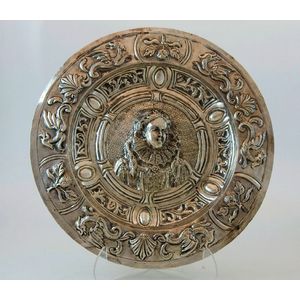Etruscan Revival Micro-Mosaic Bee Brooch
You must be a subscriber, and be logged in to view price and dealer details.
Subscribe Now to view actual auction price for this item
When you subscribe, you have the option of setting the currency in which to display prices to $Au, $US, $NZ or Stg.
- Polychrome - Made or finished in many colours. For furniture, it is used to indicated a painted finish.
- Etruscan - The Etruscans were pre-Roman people who mainly inhabited central and part of north Italy, in the area corresponding to Tuscany. The civilisation was active from around 700BC until their assimilation into the Roman Empire in around the 4th century BC.
With the increasing importance of Rome they were virtually wiped out, for Rome would not tolerate a competitive civilization. Many Etruscan rituals and aspects of their culture were taken over by Rome: Etruscan funeral games became the Roman gladiatorial combats and the science of divination came from the Etruscans.
They were also incredible craftsmen in precious metals. It was said that the famous Etruscan Sibylline books of received wisdom were burnt by Rome and that the emperor Claudius was the last person who could read Etruscan, a language that is still largely undeciphered.
Black and red figure vases attributed to the Etruscans provided the basis for the Etruscan style of furniture, decorative arts and decoration first seen in Louis XVI furniture in the 1760s, and then adapted by Robert Adam in England.
The style was characterised by the use of the red and black colourways of the vases, together with motifs such as lions, birds, sphinxes and griffins.
Josiah Wedgwood was inspired by the civilisation, and in 1769 he opened his new ceramic factory at Stoke-on-Trent, naming it "Etruria Works". Using the modeller John Flaxman, he produced wares based on what was thought at the time, to be Etruscan themes.
At the end of the 18th and in the early 19th century, Etruscan themes were seen in glass, jewellery and furniture, and in the 1820s Coalport China produced a range of wares based on the Etruscan themes.
Around that time it was discovered that the archaeological treasures attributed to the Etruscans were of Greek origin, but the description of them as "Etruscan" continued. - Bee Motif - The bee is a popular motif in jewellery design, often used to symbolize industry, hard work, and the natural world. They can be depicted in a variety of styles, from realistic to stylized, and are often used as a decorative element on rings, pendants, earrings, and other types of jewellery. In many cultures, bees are also seen as a symbol of prosperity and good luck, making them a popular choice for talismanic jewellery. Some people also choose to wear bee-themed jewellery as a way to show support for the conservation of bees, which are important pollinators that play a vital role in the health of ecosystems around the world.
- Gilding - Gilding is a method of ornamentation whereby a thin sheet of gold metal is applied to items made of wood, leather, ceramics, glass and silver for decorative purposes.
For furniture including mirrors, the sheet of gold is usually applied over a coating of gesso. Gesso is a mixture of plaster of Paris and gypsum mixed with water and then applied to the carved wooden frames of mirrors and picture frames as a base for applying the gold leaf. After numerous coats of gesso have been applied, allowed to dry and then sanded a coat of "bole", a usually red coloured mixture of clay and glue is brushed on and allowed to dry, after which the gold leaf is applied. Over time parts of the gilding will rub off so the base colour can be seen. In water gilding, this was generally a blue colour, while in oil gilding, the under layer was often yellow. In Victorian times, gilders frequently used red as a pigment beneath the gold leaf.
Metal was often gilded by a process known as fire gilding. Gold mixed with mercury was applied and heated, causing the mercury to evaporate, the long-term effect of which was to kill or disable the craftsman or woman from mercury poisoning. The pursuit of beauty has claimed many victims, not the least of which were the artists who made those pieces so highly sought after today.
This item has been included into following indexes:
Visually similar items

An antique emerald and pearl brooch, of circular design featuring engraved leaf decoration, set throughout with pearls and foil backed emeralds, glazed section to the reverse, mounted in 9ct gold

Victorian 18th century type silver alms dish, repousse work border of dragons, shells and fruit and central boss of a Tudor lady 37 cm diameter

An Australian 9ct yellow and rose gold medal by JM Dempster, Sydney, engraved filigree with initials EEMG, reverse engraved St Paul's Sunday school. Highest prize (girls) Edna EM Greenaway. 31st May 1911. Stamped JMD. Total weight 5.7grams.

Four various silver plated trays, glass and plate dish, coasters and cruet items
